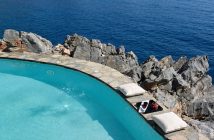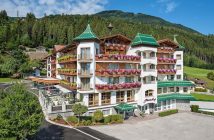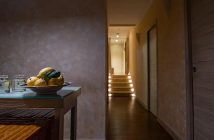Spas are, of course, all about relaxation – but this is a concept that can be defined in many ways. So, as far as I’m concerned, for a spa to offer true relaxation, it needs to have certain qualities. It goes without saying really that it has to have a calm atmosphere, well-trained therapists and luscious products. But there are other, less tangible, qualities. Quiet and tranquillity are important. Clean air and therapeutic waters highly desirable. And, of course, a beautiful natural environment.
So, tick all of those boxes and then add the Matterhorn at the bottom of your garden.
The Riffelalp is Europe’s highest spa at 2222m and it faces what is surely the continent’s most iconic mountain. The air is so clean you can taste it (and also quite thin at this altitude, so good for training athletes). And its water comes from mountain springs. The surrounding alpine meadows have more wild flowers than I’ve ever seen in one place and the mountain itself is hypnotic. Over three short days, I saw it pink, then golden in the sunrise against a cloudless blue sky; surrounded by stars so big and bright they seemed in touching distance; chased by shadows of clouds across glistening glaciers; and dramatically backlit by sheet lightning. It’s a setting where you can feel your stress just dropping away.

So part of the spa experience here means using the natural surroundings themselves. There are all kinds of walks and hikes (climbs for the more adventurous); there are bikes provided by the resort and mountain biking really means what it says here; for a shot of adrenalin you can paraglide or even go for a spin in a helicopter around the Matterhorn. And, because of the famous glaciers, you can even try summer skiing. This is not a spa for the sedentary.
Having said that, there is an excellent hydrotherapy spa with a variety of inside and outside rooms and little sun-trap terraces designed for relaxing while gazing at the mountains. There are hot and cold experiences including an ice cave and a rather large bucket of cold water for dousing; a warm scented “bio-sauna”; a very hot Finnish sauna; a steam room and a “cave” with a Heath Robinson-ish contraption that slowly oscillates an iron bucket of hot coals between furnace and water – plunging in to create steam accompanied by much hissing and spitting. The indoor pool is heated to 30C, the outdoor one to 35C and they are together the highest pools in Europe. The pools are the only places, incidentally, where you can wear anything. The rest is swimsuit verboten, though you can drape yourself in a towel if you wish (the locals don’t bother, of course).

The treatments are very much about health and wellness here. So don’t expect facials and manicures. Instead choose from a variety of scrubs, wraps and massages using local products and ingredients. Looking for something a bit different – and a balm for my dry skin – I went for the Goat’s Milk Scrub. This combines ground chestnut for the exfoliating bit and goat’s milk (though maybe this was butter, certainly it felt richer than milk) and it is massaged in for half an hour or so, rather than the usual quick scrub on and off. Afterwards you are wrapped in plastic and something like a huge waterproof duvet while you float in warm water – the massage bed opens up to become your very own flotation tank.
After all of this was showered off, my skin was soft as, well, butter and I opted next for an aromatherapy massage for total relaxation. There are lots of other massage options – hot stone, a warm, oily Abhyanga, Hawaiian lomi lomi, lymphatic drainage and reflexology.
This is not an abstemious spa when it comes to food. There are two main restaurants open in the summer, though another two open in the winter skiing high season. The five-star gourmet Restaurant Alexandre is the finest dining and features a five-course “surprise menu” as well as a la carte; al Bosco has a more casual feel with an Italian accent and tables outside as well as in; in the winter the Walliserkeller is super-cosy with a big open fire and local specialities like fondue and raclette.

If you want to start the relaxation process early, you can get to the Riffelalp by the invariably reliable Swiss train system. From Geneva, you travel for almost an hour past the city’s huge lake and then start to climb. The stations gradually become wooden chalets, balconies overflowing with scarlet geraniums and the landscape takes on an ever-grander aspect. Before I reached Zermatt, I’d already seen one chamois and I saw a second one on the cog-train from Zermatt up to Riffelalp (it has its own station and a tram to take you to the front door).
And once you’re at that front door, you may think the Riffelalp seems vaguely familiar. You’d be right. This was the Swiss hotel that featured in The Night Manager. Well, if it’s good enough for Hugh Laurie…
For more information about the Riffelalp Resort, visit www.riffelalp.com
Swiss Travel System. For transfer tickets (trains you’re your airport to destination, from £116) and travel pass (unlimited travel on rail, bus, boat, trams and free museum entrance, from £197). For more information, visit www.swisstravelsystem.co.uk
For more info on travel in Switzerland, visit www.MySwitzerland.com




